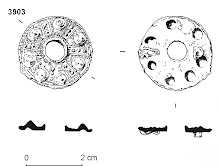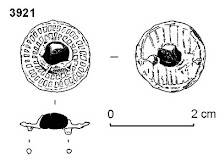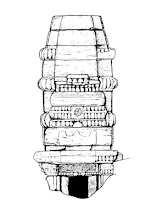 |
| Composite illustration of a late medieval Malvernian ware dripping dish from Horse and Groom Inn |
The image is of a late medieval 'Malvernian ware' dripping dish from the Horse and Groom Inn site in the Cotswolds. The dish was found smashed on the floor of the medieval farmhouse, with other sherds found in a rubble deposit a few metres away. It may have been broken during the clearing out of the building before their demolition.
The dripping dish would have been used whilst roasting meats, and its presence, alongside fragments from other dripping dishes, suggests the buildings were a wealthy peasant or manorial site.
The dish would have had a handle on just one side, with spouts at each end. The dripping dish is in an orange fabric with a copper-speckled orange glaze on the inner surface; the outer surface is fairly heavily sooted from use. The dripping dish probably dates from the 15th century.
I have prepared two illustrations of the dish, a traditional pen and ink line and stipple drawing - cleaned up and enhanced in CorelDRAW, a computer graphics package- and a composite image produced in CorelDRAW using photographs of some of the sherds, and using some of the line work of the previous drawing.
Archaeological finds drawings aim to accurately show the artefact, allow comparison with artefacts from other sites, subtly highlight any particular features, as well as hopefully give some 'feel' of the object. As with many archaeological techniques there are conventions and standardised ways of presenting the artefacts and these conventions allow complex objects to be 'read' easily and consistently -once you know the rules! Clarity is essential in such drawings, and traditional pen and ink drawings offer this, especially when images are often reduced to quarter-size (or smaller) for publication. Pottery specialists will want to see clues as to whether the vessel is
wheel-thrown or hand made, see sooting or other 'use' residues, all on an image perhaps only an inch high. Here the composite dripping dish drawing shows the fabric and glaze better than the 'traditional' version, but there is distortion from the photography due to the 3-D nature of the dish, and it can be hard to pick out the precise details of the form.
In this case the final publication drawing will be the traditional pen and ink version, however the composite illustration will be used for public lectures where it will be more immediately understood by those not used to archaeological conventions.
The publication venue is of critical importance in considering what approach to take: what looks good on a computer screen at one size may look terrible on a printed page or at a larger scale on a site display board. The audience is also of great importance: archaeologists will expect standard conventions to be followed, but images produced for the archaeologist may be meaningless to an audience that is unused to cross-sections, tick lines and scales.
Digital images are becoming increasingly common in archaeology, the ready availability of digital cameras means that many artefacts that would once have been drawn, are now photographed, however there are dangers with this approach, notably the distortion of more complex or 3-D objects which can be severe. The digital approach is often thought to be quicker, and therefore cheaper, than traditional drawing techniques, however for more complex objects there is often little difference in time spent, and the clarity of traditional drawings is often better, especially when objects are corroded and can look like an amorphous green lump! Whilst some flat artefacts can be easily photographed and checked for distortion, artefacts like broken pottery vessels can be a real nightmare to photograph, and often it just isn't possible.
For a 'traditional' drawing the pottery vessel is drawn at scale, to a
format that shows both the external and internal aspects of the vessel.
Cross-sections are used to show the thickness and form of the vessel,
and of details like the handle and spout, their positioning is shown
with 'tick-lines'. The drawing is initially done in pencil, and then
traced over in pen on a plastic draughting film called 'permatrace'.
Hand stippling and line work is added to emphasise the form and detail and
enhance the three-dimensional quality of the drawing. The drawing is
then scanned and loaded into CorelDRAW where outlines and tick-lines
are redrawn using the computer pen tools -this allows you to select a
specific line-width, and alter it to suit the final image- and the
cross-sections are filled. The different component parts of the image
can be moved around and the layout finalised.
Most
of those stages are also needed for composite drawings, instead of the
line and stipple detail the photographs are used, however nearly all
other stages must be done to produce a drawing that is readable by pottery specialists who need to compare forms and sizes across multiple assemblages.
One final aspect that is often overlooked is that with traditional drawings the illustrator has to look very closely at every artefact, from every angle, and may notice construction details that may be otherwise missed. These details can be accentuated and brought out in the finished drawing and also passed back to the artefact specialist.
As with everything, the final decision on the type of illustration should be made by actively considering the needs of both the individual artefact and the assemblage as a whole, the publication venue, scale and format. There is no simple rule, and both techniques are very useful and indeed compliment each other.



















No comments:
Post a Comment